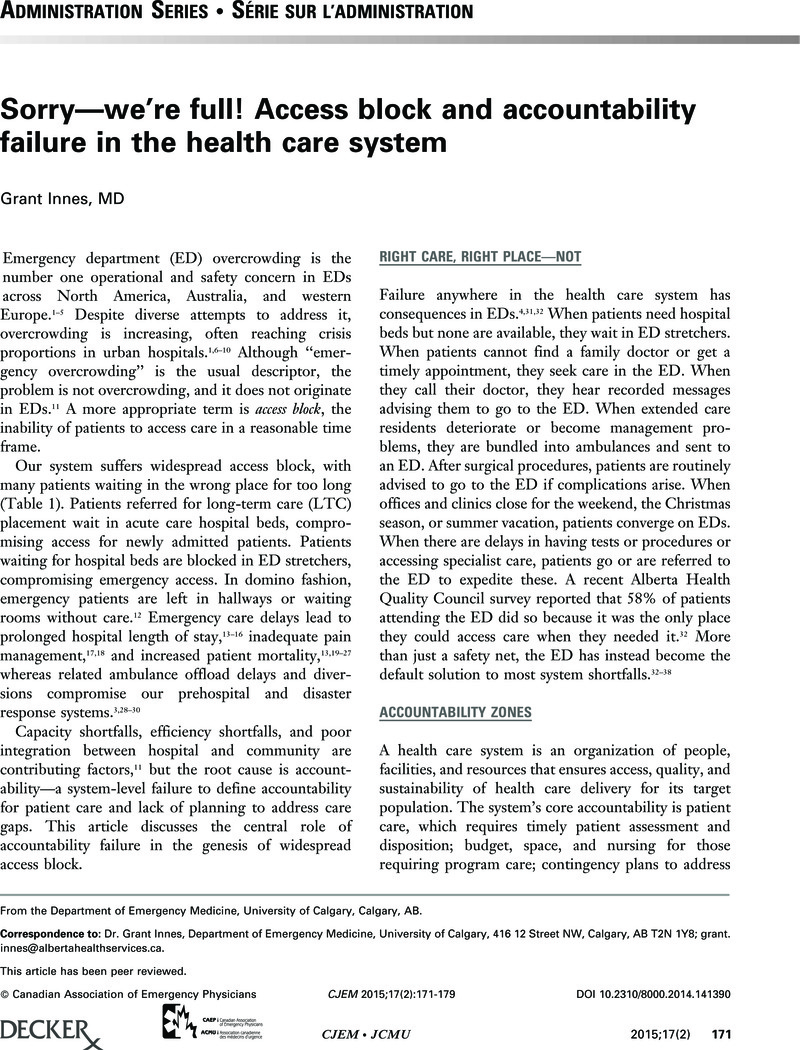Crossref Citations
This article has been cited by the following publications. This list is generated based on data provided by Crossref.
Campbell, Samuel G.
Croskerry, Pat
and
Petrie, David A.
2017.
Cognitive bias in health leaders.
Healthcare Management Forum,
Vol. 30,
Issue. 5,
p.
257.
Theou, Olga
Campbell, Samuel
Malone, Michael L.
and
Rockwood, Kenneth
2018.
Older Adults in the Emergency Department with Frailty.
Clinics in Geriatric Medicine,
Vol. 34,
Issue. 3,
p.
369.
Innes, Grant
2018.
Accountability: A magic bullet for emergency care delays and healthcare access blocks.
Healthcare Management Forum,
Vol. 31,
Issue. 5,
p.
172.
Petrie, David A.
2018.
Crowding, Karenina, and Complexity: Patient Flow in Evolving Health Care Ecosystems.
CJEM,
Vol. 20,
Issue. 1,
p.
12.
Cheng, Ivy
Zwarenstein, Merrick
Kiss, Alex
Castren, Maaret
Brommels, Mats
and
Schull, Michael
2018.
Factors associated with failure of emergency wait-time targets for high acuity discharges and intensive care unit admissions.
CJEM,
Vol. 20,
Issue. 1,
p.
112.
Reddy, Sandeep
Fox, John
and
Purohit, Maulik P
2019.
Artificial intelligence-enabled healthcare delivery.
Journal of the Royal Society of Medicine,
Vol. 112,
Issue. 1,
p.
22.
Innes, Grant
Pauls, Merril
Campbell, Samuel G.
and
Atkinson, Paul
2019.
CJEM Debate Series: #HallwayMedicine – Our responsibility to assess patients is not limited to those in beds; emergency physicians must assess patients in the hallway and the waiting room when traditional bed spaces are unavailable.
CJEM,
Vol. 21,
Issue. 5,
p.
580.
Innes, Grant D.
Sivilotti, Marco L.A.
Ovens, Howard
McLelland, Kirstie
Dukelow, Adam
Kwok, Edmund
Chopra, Anil
Cheng, Ivy
Kalla, Dan
Mackinnon, David
Kim Sing, Chad
Barclay, Neil
Ross, Terry
and
Chochinov, Alecs
2019.
Emergency overcrowding and access block: A smaller problem than we think.
CJEM,
Vol. 21,
Issue. 2,
p.
177.
Doudareva, Evgueniia
and
Carter, Michael
2021.
Using Discrete Event Simulation to Improve Performance At Two Canadian Emergency Departments.
p.
1.
Atkinson, Paul
and
Innes, Grant
2021.
Patient care accountability frameworks: the key to success for our healthcare system.
Canadian Journal of Emergency Medicine,
Vol. 23,
Issue. 3,
p.
274.
Atkinson, Paul
McGeorge, Ken
and
Innes, Grant
2022.
Saving emergency medicine: is less more?.
Canadian Journal of Emergency Medicine,
Vol. 24,
Issue. 1,
p.
9.
Doudareva, Evgueniia
and
Carter, Michael
2022.
Discrete event simulation for emergency department modelling: A systematic review of validation methods.
Operations Research for Health Care,
Vol. 33,
Issue. ,
p.
100340.
Mushtaq, Saima
Abro, Muhammad Tarish
Sualeh, Muhammad
and
Uddin, Muhammad Roohan
2022.
Profile of Geriatric Patients Attending the Emergency Department of a Tertiary Care Hospital in Karachi: A Cross-Sectional Study.
Cureus,
Ayvaz, Erdal
Kaplan, Kaplan
Kuncan, Fatma
Ayvaz, Ednan
and
Türkoğlu, Hüseyin
2022.
Reducing Operation Costs of Thyroid Nodules Using Machine Learning Algorithms with Thyroid Nodules Scoring Systems.
Applied Sciences,
Vol. 12,
Issue. 22,
p.
11559.
Reid, Natasha
Gamage, Thakeru
Duckett, Stephen J
and
Gray, Leonard C
2023.
Hospital utilisation in Australia, 1993–2020, with a focus on use by people over 75 years of age: a review of AIHW data.
Medical Journal of Australia,
Vol. 219,
Issue. 3,
p.
113.
Campbell, Samuel
Henneberry, Ryan
Clouston, Robin
and
Atkinson, Paul
2023.
The CJEM Debate Series. #ExtendedTraining: Would extended family medicine training programs be a win for emergency medicine? Or another barrier in training emergency physicians?.
Canadian Journal of Emergency Medicine,
Vol. 25,
Issue. 12,
p.
938.





